Bulletin – December 2010 The Financial Position of Australian Unlisted Businesses
Abstract
Using a variety of information sources, the financial position of unlisted firms in recent years is examined and compared with that of the broader business sector. Despite some downward pressure on profits in 2009, ongoing profitability of firms in the unlisted sector has provided a flow of internal funds that has helped the sector to reduce gearing. Among other similarities, median gearing of unlisted businesses appears to be broadly comparable to that of listed firms.
Introduction
The financial health of the business sector has implications for the economy and financial system. Most disaggregated analyses have focused on companies listed on the Australian Securities Exchange (ASX), as stringent public disclosure requirements for listed companies make available a wider range of more frequent data than is typically the case for unlisted businesses. This article draws on a variety of information sources, including a commercial dataset, to examine some characteristics of unlisted firms, including their profitability, funding and gearing.
Unlisted Firms: Data and Characteristics
Aggregate data for Australian businesses are available from a number of sources and on a number of different bases. One distinction, and the one focused on in this article, is the separation between unlisted businesses and ASX-listed companies.[1] ABS data show that in mid 2009 there were just over 2 million businesses in Australia (Table 1). At this time only around 2,000 companies were listed on the ASX. Therefore, the unlisted business sector, which includes both unincorporated businesses (for example, sole proprietorships and partnerships) and incorporated businesses, represents the bulk of total businesses by number. Unlisted businesses tend to be smaller than those on the ASX. Around 99 per cent of businesses satisfied the ABS definition of small and medium businesses by having fewer than 200 employees, while less than two-thirds of ASX-listed companies met this criterion.
| Number ('000s) | |
|---|---|
| By State/Territory | |
| Australian Capital Territory | 24.4 |
| New South Wales | 680.3 |
| Northern Territory | 13.9 |
| Queensland | 420.2 |
| South Australia | 144.7 |
| Tasmania | 37.8 |
| Victoria | 515.5 |
| Western Australia | 213.2 |
| By industry | |
| Agriculture | 203.6 |
| Construction, transport & other | 519.6 |
| Manufacturing | 91.4 |
| Mining | 7.7 |
| Rental, hiring & real estate services | 216.9 |
| Utilities | 5.6 |
| Wholesale & retail trade | 215.4 |
| Other services | 633.7 |
| All(a) | 2,051.1 |
|
(a) Excludes foreign-owned businesses operating in Australia, and businesses not yet coded to main State operations Source: ABS |
|
One source of disaggregated data on unlisted businesses is credit bureaus – companies that conduct credit checks on behalf of creditors. This article draws on a sample of data from Dun & Bradstreet (Australia) covering approximately 5,000 to 7,000 unlisted firms each year from 2005 to 2009.[2] These data are available only with a lag, largely reflecting the general lag after a reporting period for businesses to finalise financial reports, and the time it takes for these data to be compiled. The share of firms in the sample that are incorporated is higher than implied by ABS data on the full set of businesses (at around 93 per cent compared with around 67 per cent).
Unlisted businesses in the credit bureau sample tend to be small compared with ASX-listed companies: the median unlisted business had around $14 million in assets and 16 employees, compared with a median of $18 million in assets and around 65 employees for listed companies. Firms in this sample have been grouped by state, industry and size.[3] By state, the sample proportions were stable over the observed period, and broadly similar to that of aggregate ABS data. The industry breakdown in the credit bureau sample, however, does not match the ABS distribution of Australian businesses particularly closely, possibly reflecting the higher number of incorporated entities in the sample. As a result, some industries (such as manufacturing) are over-represented, while others (such as rental, hiring & real estate services) are under-represented.
Profits
In line with strength in the overall economy over the past decade or so, a range of measures show that total business profits increased in most years (Graph 1). However, in late 2008 and the first half of 2009 total profits declined, largely reflecting a fall in profits for incorporated businesses, as shown by the sharp fall in gross operating surplus (GOS), before rebounding in the latter part of 2009. These fluctuations appear to have been largely driven by listed companies, given the magnitude of the movement in listed sector earnings before interest, taxation, depreciation and amortisation (EBITDA). Profits of listed resource companies heavily influenced the overall movement, with their recent strength underpinned by elevated commodity prices.
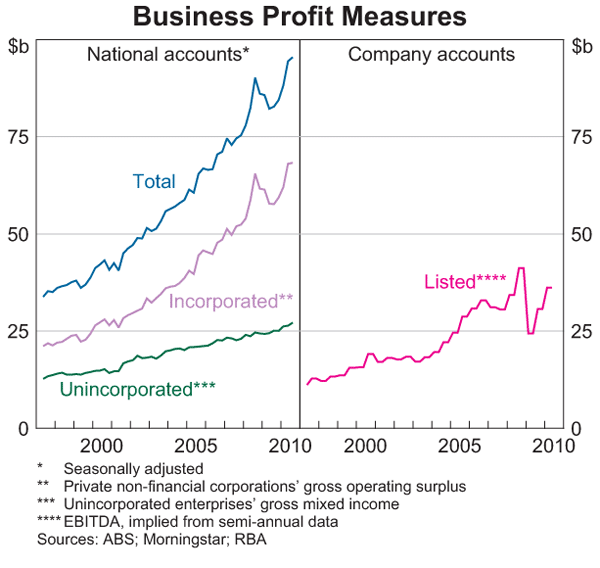
The national accounts measure of profits for the unincorporated sector was more stable, showing a similar although less pronounced movement as profits of the incorporated sector. This is also reflected in more partial measures, such as the PwC Private Business Barometer, which suggested average profit growth rates of private businesses (of which all are unlisted) halved over 2008 and 2009 (Graph 2). Since then, the survey reports that both actual and expected profit growth have recovered to be above levels prevailing prior to the financial crisis.
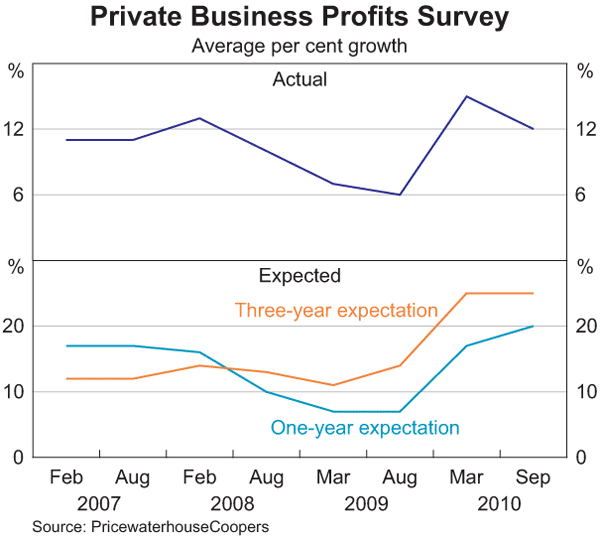
Credit bureau data offer a further view on the effect of the downturn in conditions on the unlisted sector. In 2009, the median return on assets (ROA) of all firms in the sample declined slightly to 5 per cent, as the median ROA fell across most industries (Graph 3). Unlisted firms' ROAs were widely dispersed: the top 25 per cent of firms had a ROA of around 15 per cent in each year of the sample, while the ROA of firms at the 25th percentile were only slightly positive. By industry, the highest median ROA was for construction at an average of 12 per cent each year. The lowest median ROAs were below 3 per cent and were recorded for firms in the agriculture and other services industries.
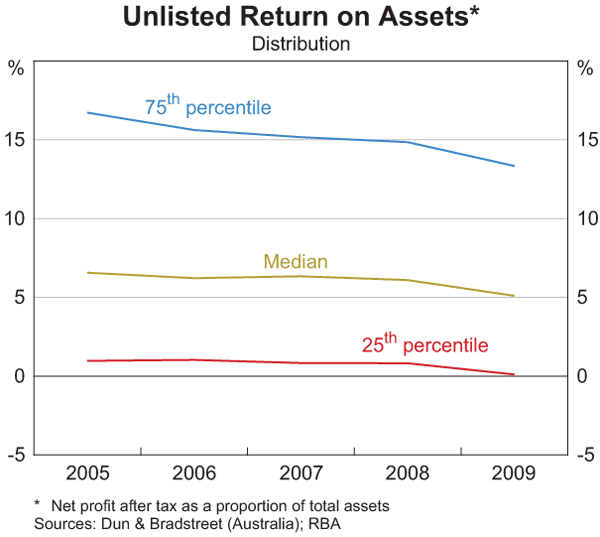
Similarly, the proportion of unlisted businesses in the sample making net losses after tax rose from 19 per cent in 2005 to 24 per cent in 2009 (Table 2). Losses were most prevalent among smaller firms (assets under $1 million), where the proportion of loss-makers rose from 24 per cent in 2005 to 34 per cent in 2009. The industries with the largest shares of loss-makers were mining and agriculture. The mining industry is characterised by more speculative, exploratory ventures that involve a large upfront investment with a long lead time in payoffs, while drought conditions in some regions may have played a role in results for the agriculture industry. The share of loss-makers in these industries remained relatively stable over the observed period, but rose for all other industry groups between 2008 and 2009. The upward trend in the proportion of businesses making losses over 2008 and 2009 was also evident in all States.
| 2005 | 2006 | 2007 | 2008 | 2009 | |
|---|---|---|---|---|---|
| By size (total assets) | |||||
| Less than $1 million | 24 | 26 | 27 | 26 | 34 |
| $1 million to $9 million | 19 | 19 | 21 | 22 | 25 |
| $10 million to $99 million | 17 | 18 | 18 | 17 | 21 |
| $100 million or greater | 16 | 19 | 18 | 17 | 22 |
| By industry | |||||
| Agriculture | 26 | 33 | 30 | 32 | 31 |
| Construction, transport & other | 15 | 11 | 12 | 10 | 16 |
| Manufacturing | 17 | 19 | 20 | 18 | 24 |
| Mining | 41 | 40 | 41 | 45 | 41 |
| Rental, hiring & real estate services | 22 | 21 | 23 | 23 | 31 |
| Utilities | 20 | 22 | 24 | 19 | 26 |
| Wholesale & retail trade | 15 | 15 | 15 | 13 | 17 |
| Other services | 22 | 23 | 23 | 25 | 28 |
| Total | 19 | 20 | 20 | 20 | 24 |
|
(a) Share of firms with negative net profit after tax in the year Sources: Dun & Bradstreet (Australia); RBA |
|||||
Some of these characteristics are also evident among ASX-listed companies. Listed companies recording losses tended to be reasonably small, and highly concentrated in the resources sector. Over the sample period, on average only one in five listed resource companies were profitable. Resource companies make up nearly half of the listed sector by number, so the overall proportion of loss-makers by number is higher than it is for the sample of unlisted businesses (only around 4 per cent of the unlisted sample are mining companies). Aggregate ABS data on loss-makers (both listed and unlisted) suggest that around a quarter of all businesses incurred net losses over the same period.
The more subdued profit performance in 2009 is reflected in a pick-up in measures of unlisted firms' financial difficulty. Business-related bankruptcies have risen since March 2009, but remain only slightly above their long-run average and are still substantially below the levels seen in the early 1990s. Total non-performance rates of banks' domestic business assets have increased in each quarter since mid 2008, though since March 2009 these have been driven by loans to incorporated businesses, where the non-performance rate reached 4.9 per cent in the June quarter 2010. In contrast, the non-performance rate on unincorporated businesses has improved so far in 2010 and is currently over half the rate for incorporated businesses of 2.6 per cent (Graph 4).
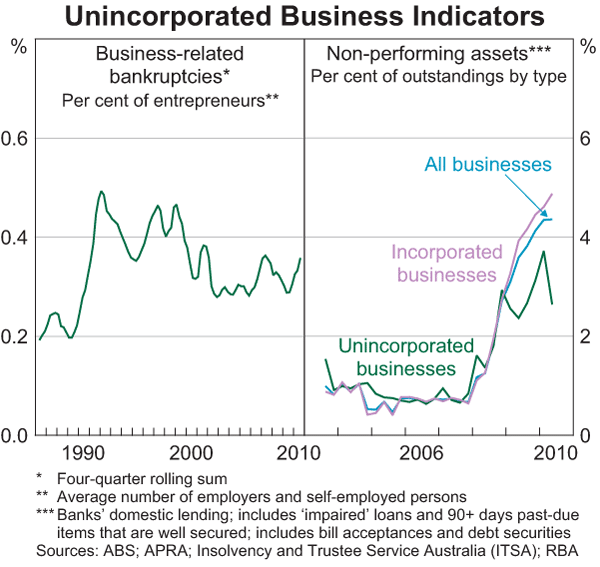
Funding
Businesses typically use a combination of internally generated funds and funds obtained through external sources to finance their operations (Graph 5). However, the range of potential sources of external funds is generally narrower for unlisted businesses than for listed companies. Non-intermediated debt instruments, such as bonds and commercial paper, that are available for some larger listed companies are less accessible to smaller businesses. And while listed firms can access public equity markets, equity finance for unlisted businesses (particularly for unincorporated businesses) is commonly limited to the personal capital of the owners, reflecting the limited secondary market and potentially higher cost of these forms of finance. Some unlisted businesses have access to venture capital markets, although this market remains small. Industry estimates suggest Australian venture capital funds under management were only about $2.5 billion or 0.2 per cent of GDP as at September 2010.
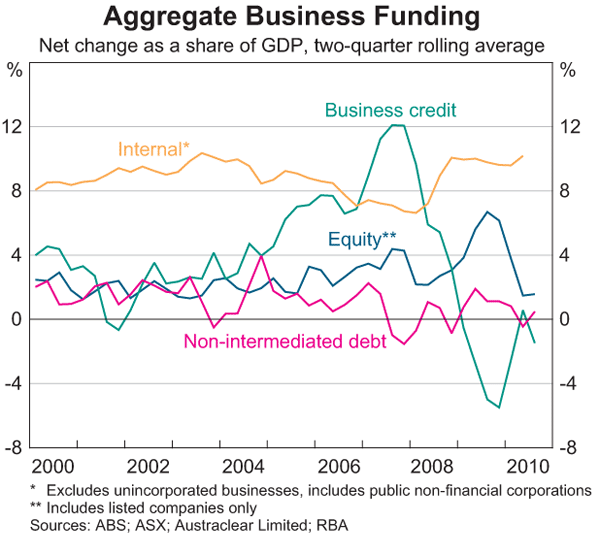
For external funding, unlisted businesses are typically large users of intermediated credit, with this creating important links between these businesses and lending institutions. It is difficult to identify loans made to the unlisted sector, although some indications can be obtained from other sources. Loans to unincorporated businesses accounted for around 16 per cent of Australian intermediated business credit as at October 2010 (Graph 6). The major banks provided just under 80 per cent of this, although unincorporated lending was only 6 per cent of their total loans. Other Australian and foreign-owned banks each accounted for around 10 per cent of bank loans to unincorporated businesses. To the extent that unlisted businesses are likely to make greater use of smaller loans, lending by loan size (business loans above and below $2 million) is a further source of information. In June 2010, loans below $2 million constituted around 30 per cent of bank lending, and around 80 per cent of these loans were provided by the major banks.[4]
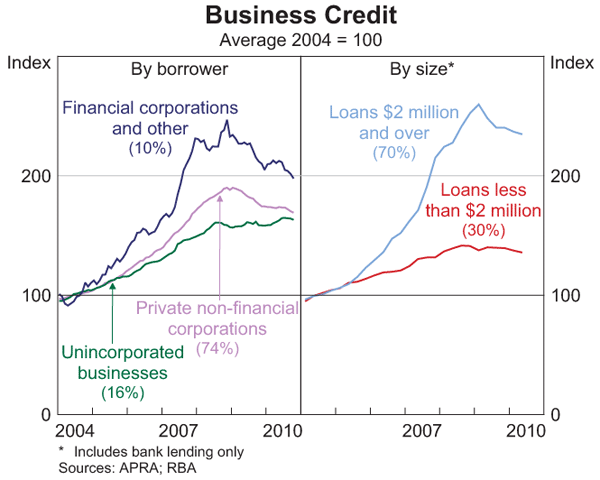
Business credit has fallen since early 2009, while lending to unincorporated businesses and loans below $2 million have remained broadly steady, suggesting the share of business credit extended to unlisted businesses may have been rising. Consistent with this, listed companies have reduced their use of debt financing in each reporting period since the peak of around $413 billion at end 2008, as they increased their use of equity financing.[5]
Another source of funding for the unlisted sector is trade credit – the financing of the purchase of goods or services by their supplier. This type of credit establishes important financial links between non-lending Australian businesses. For the median firms in the credit bureau sample, trade credit averaged half of liabilities from 2005 to 2009.[6] The wholesale & retail trade and construction industries were the highest users of trade credit: the median share of trade credit averaged over 60 per cent of these industries' liabilities. Consistent with the listed sector, the sample suggests smaller firms tended to use more trade credit. The use of trade credit by businesses in the credit bureau sample is higher than suggested by aggregate ABS data, which imply that trade credit represented no more than 10 per cent of Australian business' liabilities in any year from 2005 to 2009.
Trade credit may be one of the riskier forms of credit, reflecting its typically unsecured nature and the high cost of monitoring related exposures. Insolvency and Trustee Service Australia (ITSA) data suggest that trade creditors bear a significant share of losses from bankruptcies (Graph 7). The largest share of unsecured liabilities is in the ‘other’ category (which includes trade creditors), with this being generally higher than the exposures of other key creditors such as banks and finance companies.
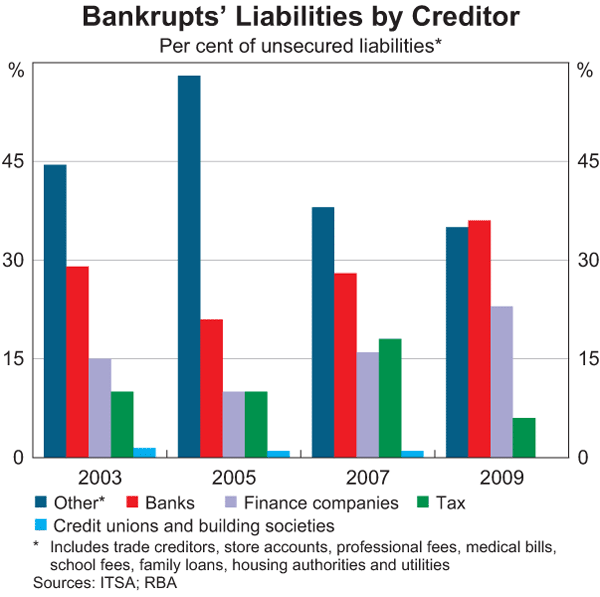
Gearing
Unlisted businesses' gearing declined across a range of measures from 2005 to 2009, reflecting an increase in equity that was likely to have been associated with the sector's broad profitability. A common gearing measure – the debt-to-equity ratio – can be estimated from the credit bureau database, where debt is estimated as total liabilities minus trade credit. Under this approach, the median debt-to-equity ratio of unlisted firms fell from 52 per cent in 2005 to 41 per cent in 2009 (Graph 8). However, the median gearing ratio masks large variations across the sample. Over the sample period, more than a quarter of firms had an estimated debt-to-equity ratio of above 100 per cent, while around a quarter had a ratio below 15 per cent.
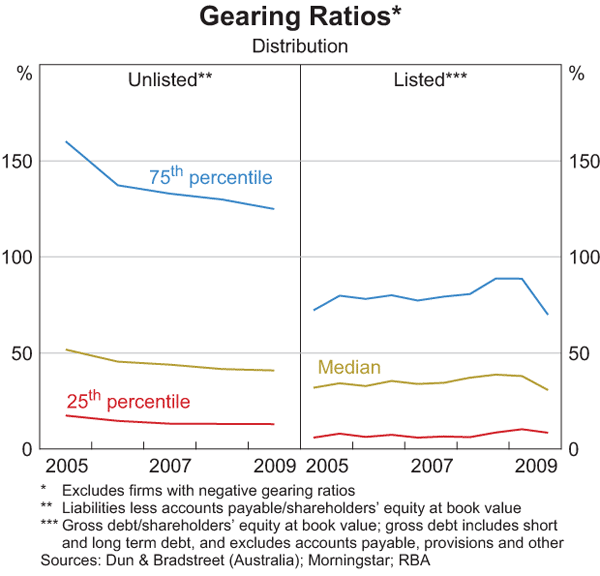
The median debt-to-equity ratio for ASX-listed companies was around 35 per cent, on average, from 2005 to 2009. On the evidence from the credit bureau sample, the distributions of gearing ratios in the unlisted and listed sectors share many similarities. One key difference was that while the unlisted sector exhibited a stable deleveraging trend from 2005 to 2009, listed firms increased their gearing until end 2008 before a period of significant deleveraging. This was mostly accounted for by larger firms: the firm at the 90th percentile of the 250 largest listed companies had an average debt-to-equity ratio of 244 per cent at end 2008, which fell to 194 per cent by the end of 2009. Another difference is that unlisted businesses in the sample relied more on trade credit than their listed counterparts. If trade credit is not removed from liabilities, the median ratio of total liabilities-to-equity averaged 111 per cent for the sample of unlisted businesses, over four times higher than the equivalent ratio for all listed companies.
In any given year, more than half the unlisted firms in the credit bureau sample reduced their debt-to-equity ratios. Despite this, most unlisted firms were still expanding their balance sheets (Graph 9). Firms expanding their balance sheets accounted for just over 70 per cent of the sample each year until 2008, before falling as pressure increased on profits.
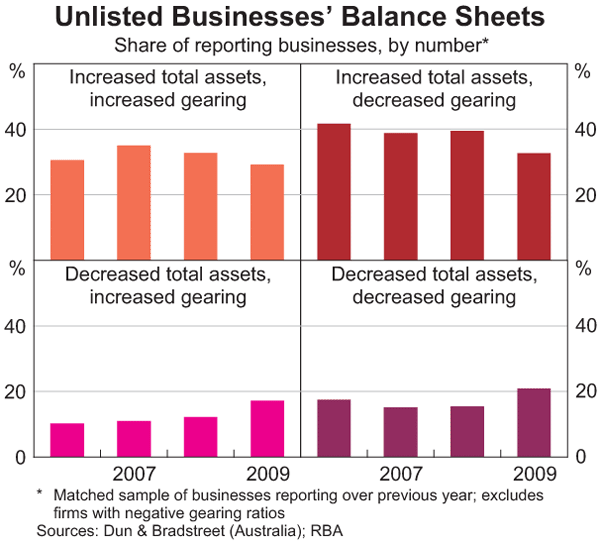
By industry, gearing ratios were highest for unlisted businesses in the utilities, and rental, hiring & real estate services industries, with median debt-to-equity ratios for both industries consistently above 75 per cent (Graph 10). The mining industry relies less on debt funding than other industries: median debt-to-equity among unlisted mining firms averaged around 17 per cent over the sample period. Listed companies display similar industry trends: gearing was highest in the infrastructure and real estate industries, with median debt-to-equity ratios averaging 172 per cent and 88 per cent each from 2005 to 2009, while the median ratio among resource companies averaged just 11 per cent.
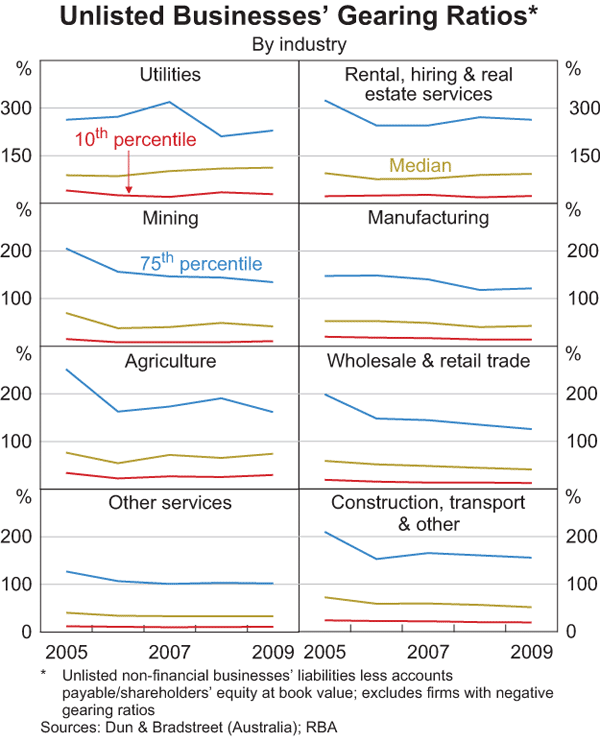
The aggregate interest-servicing ratio – a measure of interest expense as a proportion of earnings – increased for listed companies from 2005 to mid 2008 before declining, reflecting falling interest rates and gearing. The credit bureau database does not contain interest-servicing data; however, applying average interest rates to outstanding debt levels suggests interest-servicing ratios among unlisted businesses are broadly comparable to those of listed companies. In line with the listed infrastructure and real estate industries, the unlisted utilities industry appears consistently to have the highest interest-servicing ratios, followed by the rental, hiring & real estate services industry. In contrast, resources and mining firms consistently have the lowest ratios in both sectors.
Conclusion
Unlisted businesses are an important part of the business sector, with strong financial links to lending institutions (through intermediated credit) and other firms (through trade credit). Aggregate data suggest that the unincorporated sector, which makes up a large part of unlisted businesses, has had a more stable profit performance than the incorporated or listed sectors in recent years, and non-performance rates on bank exposures to the unincorporated sector have remained lower as a result. Available disaggregated data suggest that unlisted businesses have similar gearing ratios to the listed sector, and that gearing has been more stable in recent years than for the listed sector.
Footnotes
The authors are from Financial Stability Department. [*]
In this article, listed and unlisted firms are domestically domiciled non-financial and real estate businesses; however, ABS data comprise all businesses operating in Australia. [1]
Firms within the sample are anonymous, but are uniquely identified. [2]
In this article we have aggregated the industries in the ANZSIC 2006 classification into eight industry groups: agriculture (agriculture, forestry & fishing); construction, transport & other (construction, transport, postal & warehousing and other); manufacturing; mining; rental, hiring & real estate services; utilities (electricity, gas, water & waste services); wholesale & retail trade (wholesale trade and retail trade); and other services (accommodation & food services, professional, scientific & technical services, information, media & telecommunications, administrative & support services, education & training, health care & social assistance, arts & recreation services, and other services). Financial & insurance services and public administration & safety are excluded. [3]
For further information, see RBA (2010). [4]
See, for example, Black, Kirkwood and Shah Idil (2009). [5]
Trade credit data are reported as accounts payable [6]
References
Black S, J Kirkwood and S Shah Idil (2009), ‘Australian Corporates' Sources and Uses of Funds’, RBA Bulletin, October, pp 1–12.
RBA (Reserve Bank of Australia) (2010), ‘Submission to the Inquiry into Access
of Small Business to Finance’, Submission to the Senate Economics
References Committee Inquiry into Access of Small Business to Finance,
24 March.